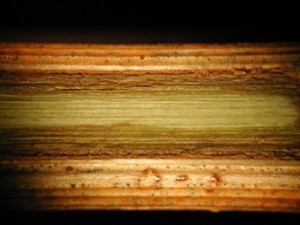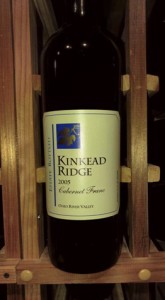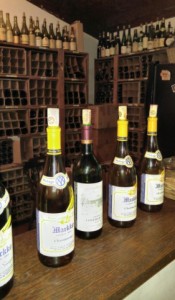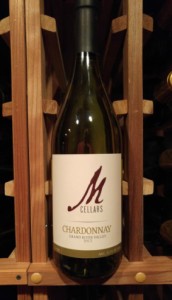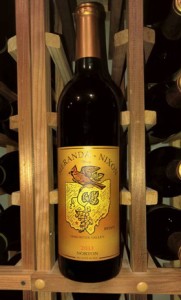Wine grapes, like Goldilocks, like it to be not too hot and not too cold. Growing grapes for fine wine requires avoiding temperature extremes. That is why most wine grapes in the world are grown between 30 degrees and 50 degrees latitude in both the northern and southern hemispheres. Those are the temperate climate zones, providing on average enough sun and a sufficient number of warm days to allow vinifera grapes to grow and ripen.
It is not just about latitude. Microclimates can alter the average temperature and rainfall within a larger zone. Many of the most prestigious wine regions in the world are located near large bodies of water like oceans, lakes, and even large rivers, which can moderate the temperatures in nearby vineyard sites.
Site selection can have other significant impacts. In France, for example, in Chablis, the most northern sub-region of Burgundy at nearly 48 degrees north latitude, the seven best (Grand Cru) vineyards are side-by-side along the Serein River, facing south and west, maximizing exposure to the sun. Hillsides and slopes also play a role. The Mosel region in Germany has some of the most northern vineyards in the world at around 50 degrees north latitude. There the vineyards overlook the river but are also severely sloped to maximize exposure to the sun by minimizing the amount of shade one row of grapevines casts on another.
Vinicultural practices can also help shape the growing season on a micro level. Removing foliage can promote air flow, reducing the risk of fungal diseases but also cooling the vine. Canopy management can also increase exposure to the sun which is important in some cooler climates.
Still, with all these efforts to ensure climactic moderation, there remains quite a bit of differentiation from one vineyard to another and even within individual vineyards, which accounts for much of the differences experienced in the wine. These differences also account for the choice of varietals grown in different areas and extends, in regions like Ohio, to decisions about which species of grapes to grow. Some grape varieties like Cabernet Sauvignon or Syrah (know as Shiraz in Australia) prefer warmer temperatures, while some, like Riesling, are more cool temperature grapes. Some species, like vitis labrusca, are in general more cold hardy.
Climate and Grape Growing in Ohio
Ohio sits squarely in the middle of the northern temperate latitudes. Conneaut, Ohio, in the Lake Erie and Grand River Valley American Viticultural Areas (AVAs), is at about 42 degrees north latitude. Ripley, Ohio, at the southern border of the state in the Ohio River Valley AVA, is just below 39 degrees north latitude, putting it just north of Napa Valley. But as I said earlier, it is not only about latitude. While Napa and the Willamette Valley experience weather patterns that are moderated by the Pacific Ocean, Ohio experiences more arctic weather patterns coming down from Canada. It is only the effect of the Great Lakes and Ohio’s rivers that makes it possible to even consider growing vinifera grapes here.
According to the Ohio State Extension Service, in recent years there has been an increase in vinifera planting in Ohio, but the winter of 2013-2014 certainly dealt a blow to the vinifera growers and winemakers here. Unseasonably warm temperatures were closely followed by the polar vortex that hit in February 2014. Temperatures in the vineyards plummeted to -14, with some unofficial reports of vineyard temperatures as low as -27. For vinifera 97 percent of the year’s statewide crop was lost, and about one-third of the vinifera vines were killed outright. Native varietals and hybrids fared significantly better, and the winter of 2014 has certainly reignited the debate over which species and varietals to grow in Ohio.
The various sides in that debate, which has been shaping Ohio’s wine industry for at least 60 years, were evident in conversations I had recently with Ohio winemakers. One, who has been making wine for about a decade, believes firmly that the production of quality, fine wines requires the use of vinifera grapes, not Native American varietals or hybrids, but this winemaker is also convinced that the climate in Ohio makes commercially-successful farming of vinifera grapes untenable. Others, like Markko Vineyards’ Arnie Esterer, believe vinifera can be successfully grown in Ohio, providing one takes certain precautions to winterize the vines, protect them from disease, and is willing to exercise patience to allow the grapes to ripen.
Other Ohio winemakers believe that Ohio’s climate makes vinifera untenable, but also believe that non-vinifera varietals make perfectly acceptable wines. The non-vinifera wines may be less complex, more fruity and made to be drunk young, but these winemakers believe, as I indicated in my previous post, that there is a substantial market for those wines.
That wide variance of opinion accounts for the broadly complex commercial wine industry in Ohio.
Ohio has about 180 active wineries, and I do not know exactly how many are involved in each type of winemaking. Nonetheless, I am confident in assessing that Ohio has winemakers who are using all or almost all estate (grown on site) fruit, some are using a significant portion of sourced (purchased) fruit, and some are sourcing juice, pre-pressed, rather than pressing the fruit themselves.
The estate fruit includes wineries growing almost exclusively vinifera varietals and those growing significant percentages of hybrids and even some native American varietals. The sourced fruit comes from many markets. Obviously California, Oregon and Washington grapes are being used in Ohio, but some Ohio winemakers are also sourcing grapes from Ohio farmers, Pennsylvania, New York and many other states. Those sourcing juice cast an even wider net, with some Ohio wineries buying juice from Europe and elsewhere. On the whole, the picture of winemaking in Ohio is quite complex, and that excludes the fruit-wine production, which is also significant in Ohio and often is made by the same houses producing grape-based wines.
The Search for a Great Ohio Wine
When I talk about finding great Ohio wines, I am talking about wines that can challenge the great wines of the world, and that means wines based on vinifera grapes. Virtually no one, and that includes those who grow, produce and promote hybrid and labrusca-based wines, believes they can approach the greatness of Bordeaux first growths or Grand Cru Burgundies. They may be pleasant and enjoyable, and some people may prefer the style to the more austere styles of the great wines, but they will lack the structure, the complexity and the balance of those great wines, and the global wine community will never consider them in the same league.
For many years, I held out the wines of Kinkead Ridge from Ripley, Ohio as prime examples of great Ohio wines, both reds and whites. While it was never the case that these wines would be mistaken for a great Bordeaux or Rhone wine, the wines of Kinkead Ridge showed great promise, with the 2005 Cabernet Franc showing exquisitely with some bottle age. The winery was recently sold, and the new owner did not purchase the vineyards. Time will tell if the promise of Kinkead Ridge will live on in the new label’s wines.
My next and new favorite Ohio wine is being produced by Markko Vineyard up in Conneaut, Ohio. Arnie Esterer became one of the original cooperators with Dr. Konstantin Frank who taught Arnie and his partner, the late Tim Hubbard, how to grow vinifera grapes in northern Ohio. Markko uses all estate-grown fruit. Arnie told me recently, “If I don’t grow it, I won’t make it.”
Markko’s Cabernet Sauvignon, which is actually a Cabernet-heavy blend with several varietals inter-planted in the vineyard, sometimes struggles to achieve full ripeness, with harvest occurring as late as November in some vintages. Yet Markko manages to produce a Cabernet with moderate extraction and pretty red fruits like sour cherry and raspberry, oak that smooths some of the fruit’s rough edges but does not overpower, and soft but assertive tannins, creating a perception of a wine fully integrated and in balance. I cannot wait to see how a couple years in the bottle treats the 2012 Markko Cabernet I have in my cellar.
The Markko Chardonnay is also an excellent wine with good acid and great balance and a hint of oak that only shows at the mid-palate, suggestive of a deft hand in the winery, allowing the fruit to show up front and the acid to carry the finish.
But the star has to be the Markko Vineyard dry Riesling. I asked Arnie how much residual sugar was in the Riesling, and he said, “None. I ferment it until there is nothing left to ferment.” As Arnie and I talked that day I visited several weeks ago, he became aware of my fondness for clean, austere, acidic wines. I was fortunate that Arnie shared with me a little of the 1997 Markko Riesling.
This is a wine that rivals Riesling from the great vineyards of France’s Alsace region. Wine geeks would say it is varietally correct, meaning that the character you would expect in a Riesling is what you get. Great minerality with petrol, lime and honeysuckle in abundance and some of the most assertive yet beautiful acid I have experienced in Riesling. Despite being a 1997 vintage, this wine feels much younger with many years of life left, undoubtedly due to the brilliantly-acidic structure. Unfortunately, there is not enough of the 1997 left for Markko to sell, but I was able to get a little of the 2006 and the 2007, which are also excellent wines.
Like Kinkead Ridge, I am not sure what the future holds for Markko Vineyard. Arnie Esterer has been at this for a long time, his partner passed away and he recently lost Linda Frisbie who for decades had been his right hand. The last two winters were very difficult; there will be no 2014 Markko wines, and probably no 2015, either. When I spoke with Arnie it was clear he still had the fire to prove that Ohio could be one of the great sources of vinifera wines, and the desire to build something lasting, but I am not sure of his path to accomplish those goals.
What Else Does Ohio Offer?
If Kinkead Ridge is in transition and there will not be any more Markko Vineyard at least for the next year or two, does Ohio have anything to offer? I am very pleased to say, “Yes it does.” I have had the good fortune over the past couple months to meet a number of Ohio winemakers and taste a good number of excellent Ohio vinifera-based wines. And I have just scratched the surface. I intend to continue to explore Ohio wines, and I am optimistic that I shall continue to find good wines from quality producers.
You can still find some Kinkead Ridge and Markko Vineyard wines available. I know that Weilands and Andersons in Columbus have a couple of white Kinkead Ridge wines, and Markko is represented by one of the distributors, so ask your wine purveyor if you want to try it, or call the winery.
For now, let me tell you about several other Ohio winemakers and their wines that I was able to find in Columbus-area wine shops and should be available at different places around the state.
M Cellars, Grand River Valley AVA, Geneva, Ohio
Owner, vineyard manager, and winemaker Matt Meineke replanted 10 acres of Niagra grapes with vinifera varieties in 2008 and 2009. M Cellars produces 14 different wines, most of them estate grown and designated Grand River Valley AVA. I have only had the opportunity to taste two of M Cellars wines, but I am enthusiastic about both, and looking forward to working my way through the portfolio!
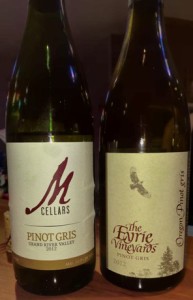
I tasted the 2012 M Cellars Pinot Gris alongside the 2012 Pinot Gris from the Eyrie Vineyards from the Willamette Valley, and it can go blow for blow with the Oregon heavyweight!
The 2012 M Cellars Pinot Gris ($17.99 retail) was the first of the M Cellars wines I tasted. There was a not-entirely-pleasant something on the nose when I first opened the bottle. Do yourself a favor and ignore that. Pour a glass, wait a minute or two, then give it a swirl. On second sniff, there was great orchard fruit like pears and apple and great minerality. The fruit on the palate tends to the tart with some citrus and sour green apple and gorgeous wet stone. There is decent acid on the back of this wine, and after a while a great black peppercorn aroma came out. I drank this alongside a 2012 Eyrie Vineyards (Willamette Valley) Pinot Gris, and this was very nearly at the Eyrie’s level.
As I write this, I am tasting for the first time the 2013 M Cellars Chardonnay ($19.99 retail), which M Cellars’ website says is produced in a Chablis style. I can see that. This does not have the acid of some of the great Chablis, nor does it have the slight greenish hue of some young Chablis, but this is an excellent example of Chardonnay. Like a good Chablis, there is great minerality here, making me wonder about M Cellars soil composition. It is classic cool-climate Chardonnay with green apple and melon and a pretty tartness that does not overwhelm. While I tend to prefer even higher acid, that would not work in this wine; it is so lean (in a good way) that more acid would destroy the balance. Getting even better as it warms slightly in the glass, this is a very nice wine.
The vines producing these wines are very young. As the vines mature and their natural complexity and character develop, future vintages should only get better.
Meranda-Nixon Winery, Ohio River Valley AVA, Ripley, Ohio
I had the opportunity to speak with Maura Meranda at the Ohio Wine Festival held at the North Market in Columbus several weeks ago. She and her husband own the vineyard and winery in southwest Ohio, producing about 2,500 cases of wine each year from grapes grown on 11.5 acres. The land has belonged to Seth Meranda’s family for generations, and in 2003 Seth began replanting the land from tobacco to a mixture of vinifera and hybrid grapes.
The 2013 Meranda-Nixon Winery Cabernet Sauvignon ($18.99) is a beautiful deep ruby color in the glass. The nose is all about cherries, both sour red cherries and black cherries, and a little eucalyptus with none of the heavy, blue, jammy fruits found in some over ripe and overly extracted versions of Cabernet. The fruit grows more tart on the palate with moderate acid and a medium finish that entices you to the next sip. This wine is not heavy with new oak, showing only the slightest vanilla and baking spice on the mid-palate. A very nice example of a dry, cool-climate Cabernet, and at 13.9 percent alcohol, this is an excellent wine that suffers only in the area of tannins which are very light for a Cabernet.
The 2013 Meranda-Nixon Norton (19.99) is a very interesting wine. The origin of the grape, Norton, also known as Cynthiana, is murky. It is of the species vitis aestivalis, which may be a naturally occurring or a deliberately-hybridized vinifera. If there is vitis labrusca in its lineage, it has lost the foxy character reminiscent of wet fur that labrusca-made wines tend to have. This wine is also a beautiful, deep ruby color and on the nose is akin to a Cabernet Sauvignon, with hints of under-ripe berries and plum. It remains tart on the palate with a good acid structure. Its tannins are a little more forward than on the Cabernet. The taste is clean, and at just 13 percent alcohol, there is a softness to the acid that leads beautifully to a lightly-oaked, medium finish. This is a very nice wine that I would love to see on the table next to a beautiful pork roast or even a lightly smoked pork or lamb.
The Judgement
The first question is, does Ohio deserve its reputation for overly-sweet wines often made from inferior grapes. At this point in time, the answer is likely yes, because there is a great deal of wine, even wines labeled as semi-dry or dry, that have a significant amount of residual sugar.
But my investigation of Ohio wines has really just started, and I am already convinced that there are more great wines being produced in Ohio than the state’s wine reputation would lead someone to believe. I have tasted wines from only a small number of Ohio’s producers and am pleased to say that I have found many very good wines made in a more international style from vinifera and other interesting grapes. I have only written about some of those wines here, but these are wines I would gladly share (and already have!) with my educated, experienced friends and colleagues in wine.
I plan to keep tasting Ohio wines, and those that I like, I will tell you about in future editions of this blog.

